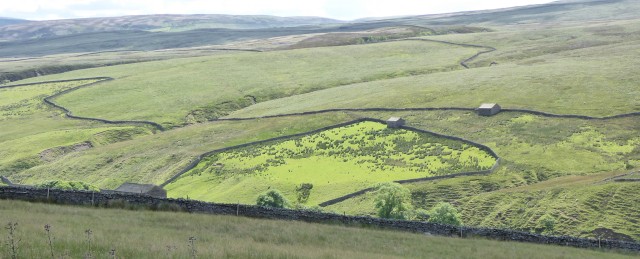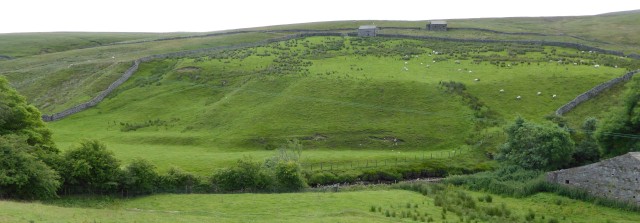
Near the start of the River Swale the bright grassy pasture of Whamp stands out amid the dull green of the moorland.

Whamp viewed from the north bank of the River Swale.
Township of Muker; tithe map ref. 325; size 4-1-10; OS grid SD864011, altitude 350m-380m; about 700 metres east of where the confluence of Birkdale Beck and Great Sleddale Beck forms the start of the River Swale; located opposite Firs farm on the north bank, between two parallel gills; a steep intake from the moor stretching down to a small, flat meadow on the south bank of the River Swale; recorded in 1844 as a meadow.
According to the celebrated dales writers Marie Hartley and Joan Ingilby, Whamp House once stood on or near to this field, and was one of a cluster of three or four riverside farmhouses that have long-since disappeared. The field that wraps around Whamp is called Burnt House Close, which seems to be a clue to the location of one of them.[1]
Whamp is a very unusual word. I haven’t found another one in any place-name reference work and it’s not in the Oxford English Dictionary (OED). However, the Scottish National Dictionary (SND) lists whamp as a variant of wham, which is itself an obscure word. Wham as a topographical or place-name word isn’t in the OED either, but it is listed in the English Dialect Dictionary (EDD). It’s described as a north-country dialect word, and it is given several interpretations.
SND offers: a dale, a valley, or little glen, or a broad hollow among hills through which a stream runs, or the (steep) sides of such a hollow, a slope, a bank, a crook, a bend, or a hollow piece of ground in a field, or a depression, frequently of a marshy nature. EDD defines wham as: a swamp, a morass, a marshy hollow, a hollow part of a field, or a dale among hills, a wide, flat glen, a small valley usually with a brook, or a hollow in a hill or mountain.
Places with the element wham in the name occur in the Pennine hills of Yorkshire, Cumbria and Northumberland, as well as in Lancashire, Cheshire, Dumfries and Galloway, and as far north as the central belt of Scotland from St Andrews to Stirlingshire.[2] The geographical spread suggests it was a word introduced by the Norwegian Vikings who migrated from Ireland in the early 900s to settle in northern England and Scotland.
The EDD suggests the origin of wham is the Old Norse hvammr, which had an original meaning of a grassy slope or vale, while the English Place-Name Society’s Elements gives the original meaning of hvammr as a nook or a small valley, and suggests that the meaning of a nook or corner might have been adopted from the Old English hwamm meaning a corner or angle, usually of a building.
Whamp has a small hollow or depression on the left side of the steep slope, as can be seen in the photos above, and this might have been enough to give the field its name. However perhaps the naming was more to do with the whole field’s characteristic of a lush grassy slope. It isn’t a valley among hills but it is a stand-out pasture among an otherwise rough moorland landscape.
Other wham places are markedly different in topography and scale, which accounts for the varying interpretations that have been suggested for the word. There is one other wham place-name in upper Swaledale (see Wham Bottom), and one in Arkengarthdale (see The Wham). All three in this neck of the woods are quite different from each other.
[1] Marie Hartley and Joan Ingilby, A Dales Heritage: life stories from documents and folk memory, 2nd edn. (Otley, 1996), p. 144.
[2] OS Gazetteer of Great Britain, 3rd ed. (Southampton 1992); A H Smith, The place-names of the West Riding of Yorkshire, English Place-Name Society vols. 30-37 (Cambridge, 1961-63); A H Smith, The place-names of Westmorland, English Place-Name Society vols. 42-43 (Cambridge, 1967); A M Armstrong, A Mawer, FM Stenton, Bruce Dickins, The place-names of Cumberland, English Place-Name Society vols. 20-22 (Cambridge, 1950-52); John Field, English field names: a dictionary (Newton Abbot, 1972); Edward John-Ferguson, The place-names of Dumfriesshire (Dumfries, 1935); Scots words and place-names web site http://swap.nesc.gla.ac.uk; England’s North-East website, roots, dialects and place-names http://www.englandsnortheast.co.uk.
